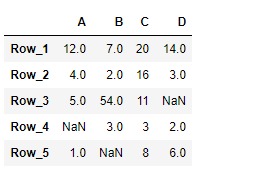Pandas DataFrame是带有标签轴(行和列)的二维大小可变的,可能是异构的表格数据结构。算术运算在行和列标签上对齐。可以将其视为Series对象的dict-like容器。这是 Pandas 的主要数据结构。
Pandas DataFrame.to_string()函数将DataFrame呈现到控制台友好的表格输出中。
用法: DataFrame.to_string(buf=None, columns=None, col_space=None, header=True, index=True, na_rep=’NaN’, formatters=None, float_format=None, sparsify=None, index_names=True, justify=None, max_rows=None, max_cols=None, show_dimensions=False, decimal=’.’, line_width=None)
参数:
buf:要写入的缓冲区。
columns:要写入的列的子集。默认情况下写入所有列。
col_space:每列的最小宽度。
header:写出列名。如果给出了字符串列表,则假定它是列名的别名。
index:是否打印索引(行)标签。
na_rep:要使用的NAN的字符串表示形式。
formatters:格式化程序函数可按位置或名称应用于列的元素。
float_format:格式化程序函数应用于列的元素(如果它们是浮点型)。此函数的结果必须是unicode字符串。
sparsify:对于具有层次结构索引的DataFrame设置为False,以在每一行打印每个多索引键。
index_names:打印索引名称。
max_rows:控制台中要显示的最大行数。
max_cols:控制台中要显示的最大列数。
show_dimensions:显示DataFrame的尺寸(行数乘以列数)。
decimal:识别为小数点分隔符的字符,例如', ' 在欧洲。
line_width:以字符换行的宽度。
返回:str(或unicode,取决于数据和选项)
范例1:采用DataFrame.to_string()函数将给定的DataFrame呈现到控制台友好的表格输出中。不要在输出中包括索引标签。
# importing pandas as pd
import pandas as pd
# Creating the DataFrame
df = pd.DataFrame({'Weight':[45, 88, 56, 15, 71],
'Name':['Sam', 'Andrea', 'Alex', 'Robin', 'Kia'],
'Age':[14, 25, 55, 8, 21]})
# Create the index
index_ = pd.date_range('2010-10-09 08:45', periods = 5, freq ='H')
# Set the index
df.index = index_
# Print the DataFrame
print(df)输出:

现在我们将使用DataFrame.to_string()函数将给定的DataFrame呈现到控制台友好的表格输出中。
# print in tabular format
result = df.to_string(index = False)
# Print the result
print(result)输出:

正如我们在输出中看到的,DataFrame.to_string()函数已成功将给定的数据帧呈现到控制台友好的表格输出中。
范例2:采用DataFrame.to_string()函数将给定的DataFrame呈现到控制台友好的表格输出中。用字符串“ Missing”表示给定 DataFrame 中的缺失值。
# importing pandas as pd
import pandas as pd
# Creating the DataFrame
df = pd.DataFrame({"A":[12, 4, 5, None, 1],
"B":[7, 2, 54, 3, None],
"C":[20, 16, 11, 3, 8],
"D":[14, 3, None, 2, 6]})
# Create the index
index_ = ['Row_1', 'Row_2', 'Row_3', 'Row_4', 'Row_5']
# Set the index
df.index = index_
# Print the DataFrame
print(df)输出:

现在我们将使用DataFrame.to_string()函数将给定的DataFrame呈现到控制台友好的表格输出中。
# print in tabular format
result = df.to_string(na_rep = 'Missing')
# Print the result
print(result)输出:

正如我们在输出中看到的,DataFrame.to_string()函数已成功将给定的数据帧呈现到控制台友好的表格输出中。
相关用法
- Python pandas.map()用法及代码示例
- Python Pandas Series.str.len()用法及代码示例
- Python Pandas.factorize()用法及代码示例
- Python Pandas TimedeltaIndex.name用法及代码示例
- Python Pandas dataframe.ne()用法及代码示例
- Python Pandas Series.between()用法及代码示例
- Python Pandas DataFrame.where()用法及代码示例
- Python Pandas Series.add()用法及代码示例
- Python Pandas.pivot_table()用法及代码示例
- Python Pandas Series.mod()用法及代码示例
- Python Pandas Dataframe.at[ ]用法及代码示例
- Python Pandas Dataframe.iat[ ]用法及代码示例
- Python Pandas.pivot()用法及代码示例
- Python Pandas dataframe.mul()用法及代码示例
- Python Pandas.melt()用法及代码示例
注:本文由纯净天空筛选整理自Shubham__Ranjan大神的英文原创作品 Python | Pandas DataFrame.to_string。非经特殊声明,原始代码版权归原作者所有,本译文未经允许或授权,请勿转载或复制。
